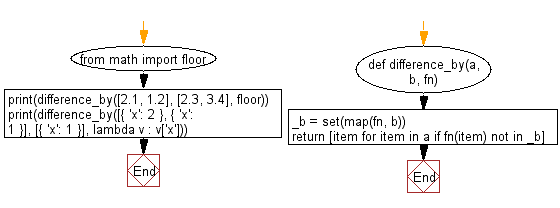Python: Get the difference between two given lists, after applying the provided function to each list element of both
Difference of Lists with Function
Write a Python program to get the difference between two given lists, after applying the provided function to each list element of both.
- Create a set, using map() to apply fn to each element in b.
- Use a list comprehension in combination with fn on a to only keep values not contained in the previously created set, _b.
Sample Solution:
Python Code:
# Import the 'floor' function from the 'math' module.
from math import floor
# Define a function called 'difference_by' that takes three arguments: 'a', 'b', and 'fn'.
def difference_by(a, b, fn):
# Create a set '_b' by applying the 'fn' function to each element in 'b'.
_b = set(map(fn, b))
# Return a list of items in 'a' for which the result of applying 'fn' is not in '_b'.
return [item for item in a if fn(item) not in _b]
# Example 1: Find the difference between two lists after applying the 'floor' function.
print(difference_by([2.1, 1.2], [2.3, 3.4], floor))
# Example 2: Find the difference between two lists of dictionaries using a custom lambda function.
print(difference_by([{ 'x': 2 }, { 'x': 1 }], [{ 'x': 1 }], lambda v : v['x']))
Sample Output:
[1.2]
[{'x': 2}]
Flowchart:

For more Practice: Solve these Related Problems:
- Write a Python program to compute the symmetric difference between two lists after applying a transformation function to each element.
- Write a Python program to get the difference between two lists using a lambda function that rounds each element to one decimal place.
- Write a Python program to calculate the difference between two lists where each element is processed by a custom function extracting a specific attribute.
- Write a Python program to determine the difference between two lists after converting all string elements to lowercase using a provided function.
Go to:
Previous: Write a Python program to randomize the order of the values of an list, returning a new list.
Next: Write a Python program to create a list with the non-unique values filtered out.
Python Code Editor:
What is the difficulty level of this exercise?
Test your Programming skills with w3resource's quiz.
